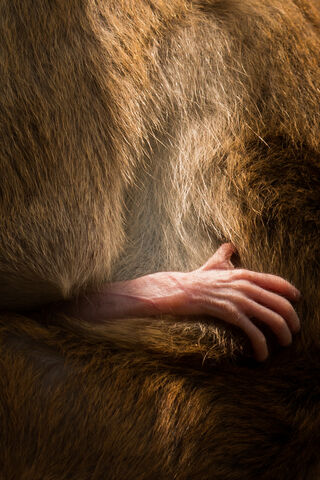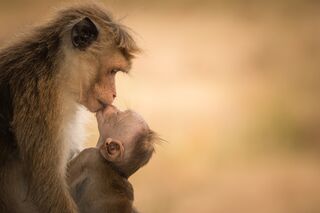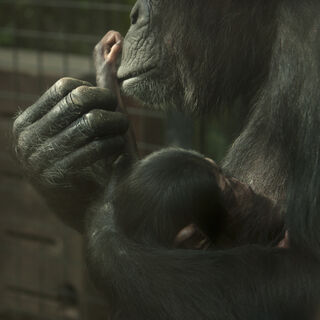Grief
Why Do Some Primate Mothers Carry Their Dead Infants?
Infant corpse carrying may arise from maternal bonds and feelings of grief.
Posted September 17, 2021 Reviewed by Davia Sills
Key points
- Infant corpse carrying by mothers (ICC) has been observed in 80 percent of primate species for which records exist.
- ICC was more likely when the infant’s death was due to illness versus traumatic causes, and when the mother was younger.
- Infants who were younger at time of death were carried longer, suggesting that ICC reflects a strong mother-infant bond.
- ICC may be an expression of grief and such death-related behaviors in other primates may be the origin of human grief and mourning practices.

According to a new study, some primate mothers appear to express grief over the death of an infant by carrying the corpse with them, sometimes for days or weeks. In the largest study of its kind, researchers from University College London compiled data from anecdotes reported in 126 scientific publications in order to quantitatively analyze infant corpse carrying behavior among primate species. The findings have implications for our understanding of how other animals experience emotion and even for the evolution of human practices around death and mourning.
Anecdotes into data
Animals exhibit many different responses to death, but infant corpse carrying by mothers (ICC) is the most frequently reported. ICC has been observed in diverse mammals, most notably primates. Despite its prevalence, quantitative analysis of ICC has been challenging, according to study co-author Elisa Fernández-Fueyo.
“Records of this behavior go way back; one was from 1915,” she says. “But they are often reported individually and the small samples sizes meant it was not possible to perform statistical analyses.”
In order to turn these anecdotes into more useful quantitative data, Fernández-Fueyo, her supervisor Alecia Carter, and their colleagues compiled a database of primate mothers’ responses to the death of an infant. The researchers identified over 400 reports of behaviors across 50 primate species.

Overall, the researchers found that ICC was widely distributed among primate species, with 80 percent of the species for which records exist demonstrating the behavior. The behavior occurred most frequently in great apes (such as chimpanzees and gorillas) and Old World monkeys (such as baboons and macaques), who also carried their infants after death for the longest durations.
Even in the primate species in which ICC has not been recorded, such as marmosets and lemurs, mothers may express grief in other ways. For instance, some of these mothers have been observed to stay with or return to the corpse of their infant for some hours and give mother-infant contact calls.
Love persevering
Among those primate species in which it has been observed, Fernández-Fueyo and her colleagues identified two factors that may help explain the likelihood of ICC.
First, younger mothers were more likely to carry their infants after death than older mothers. Second, mothers were more likely to carry infants that had died of non-traumatic causes (such as illness) versus traumatic causes (such as infanticide or accidents).
These results could suggest that primate mothers have an awareness of death or can learn about death over time. Older mothers could be more experienced at detecting death, and therefore less likely to carry a dead infant. Additionally, it is probably easier for mothers to determine that their infant is dead after traumatic injuries than an illness, which may provide fewer reliable context and sensory cues to death.

However, this interpretation assumes that ICC occurs when mothers are unaware or uncertain that their infant is dead. ICC could also be an expression of grief.
When Fernández-Fueyo and her colleagues analyzed the length of time spent carrying a dead infant, they found that the age of the infant at the time of their death mattered, with younger infants carried longer. Since younger infants are more strongly bonded with their mothers than older infants, the researchers say it’s possible that the mother-infant bond and its associated emotions drive ICC.
After the removal or accidental loss of infants’ corpses, mothers may emit alarm calls and search for the body, sometimes for hours. Fernández-Fueyo says they appear to be in distress.
“If distress can be seen as an indicator of grief, then it may be that these moms are experiencing some kind of grief,” she says. “Maybe ICC is a way of grieving.”
Social bonds may drive primates’ responses to death. And in many ways, human social bonds are similar to those of other primates. Therefore, Fernández-Fueyo says it’s not a leap to think of human grief and mourning rituals arising as an extension of the death-related behaviors seen in other primates.

The roots of grief
Scientists are just beginning to analyze other species’ death-related behaviors. To help encourage further research, Fernández-Fueyo and her colleagues launched the website ThanatoBase (named for Thanatos, the personification of death in ancient Greek mythology). Researchers are invited to contribute their own observations of non-human primates’ responses to death. The hope is that, through collaboration, more data will allow for more quantitative analyses of these behaviors.
Although ThanatoBase is focused on primates, many other kinds of animals have been observed to respond to dead individuals in some manner. Fernández-Fueyo would like to see similar publicly available databases for these species, too.
“We see death-related behaviors in elephants, giraffes, cetaceans, and other animals,” she says. “The problem is, if these are not reported, we may think that primates are special in the ways they respond to death, when actually the evolutionary roots of these behaviors may run deep in mammals.”
References
Fernández-Fueyo E, Sugiyama Y, Matsui T, Carter AJ. 2021 Why do some primate mothers carry their infant’s corpse? A cross-species comparative study. Proc. R. Soc. B 288: 20210590. Doi: 10.1098/rspb.2021.0590.




